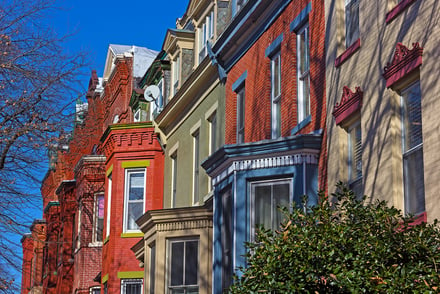Brick homes can be refreshed and beautifully transformed with the right paint job. Following a few helpful color scheme guidelines can assure a gratifying result.
Pre-Painting Considerations
Before you paint your historic brick home, do your research and make some critical observations.
- Historical relevance – If you have an HOA or live in a designated historical district, research the requirements for color choices and the exterior areas you may paint. If your home is already painted, investigate the color origins to see if they are authentic to the period. Apply a little elbow grease to see if you can uncover and detect previous color layers.
- Existing architecture – Identify your home's architectural style. Make note of any architectural details you may want to feature or minimize with the creative use of color.
- Neighboring homes – Consider how your color choices will look next to or in the context of the other homes on the block. Aim to complement rather than copy or compete.
- Surrounding landscaping – Permanent or long-term landscaping and hardscaping should influence your color choices. Consider trees and seasonal plantings that distinguish your neighborhood and yard.
Partial Brick House Painting – Coordinate With Brick Tones
If you choose to leave the body color of your home in the natural brick color, consider using two colors to accent your home. Check the color samples at different times of day to see how light affects color.
- Coordinate paints with brick tone – Take photos of the existing brick. Bring them to your color specialist at the paint store or check paint chips. Identify the brick's tones and choose your accent colors to complement or match tones of the original brick.
- Primary accent color – Limit your primary accent paint to defining areas of your home such as trim, gutters, window gables, and railings. This color needs to be somewhat neutral and might blend in with the primary or secondary tone in your brick.
- Secondary accent color – Use a secondary accent color for those special areas where a more dramatic pop of color will make a statement. Your front door, window sashes, mailbox, window planters, porch floor, or shutters are a few examples. Staying within your brick tones, choose a color that contrasts your primary accent color and brick body primary tone.
Whole Brick House Painting - Choose 3 Colors
Exteriors with a 3-color combination look clean and attractive without overdoing it.
- Primary color – Generally covers 60% of your home. Also known as the "field color," start by choosing to go light or dark. The color should deliver the impression you're looking for, whether it be a wow-factor, quiet elegance, or consistency with your neighbors.
- Secondary color – 30% of your exterior. The areas to use the secondary color are similar to the primary accent areas on a partially painted home, such as gutters, trim, railings, porch columns, moldings, and window gables. This color should only be one to two shades darker or lighter than the primary color.
- Accent color – 10% of your exterior. While the accent color should coordinate with the primary color, it should come from the contrasting side of that color wheel. Accents are reserved for specific areas, giving a dramatic or bold accent to the overall scheme, such as front doors, minor trim, window sashes, mailboxes, or window boxes. Some exterior color experts suggest that the 3rd accent color be used only on moveable parts like doors and window sashes.
Professionally licensed and insured painters will have the expertise needed to prepare and paint old brick and mortar. Be sure that you choose a painting team that comes recommended by other satisfied owners of historic brick homes.
Important Note...
If your brick and mortar need tuckpointing or other repairs, plan to address those needs first. It is never a good idea to use paint as a cover-up for deteriorating or damaged brickwork. Doing so will only trap moisture (the cause of the damage) and lead to both interior and exterior troubles. If you are not sure about your brick-and-mortar condition, ask us to come and take a look. We’ll be happy to assess and offer expert advice.
Renaissance Development professionals help owners of historic brick buildings in Washington, DC and Old Town Alexandria, VA maintain the value and beauty of their investments for at least another 100 years. Get in touch with us for a consultation today.
Apr 8, 2021 8:45:00 AM


